Who Were the Minoans and Where Did They Go?
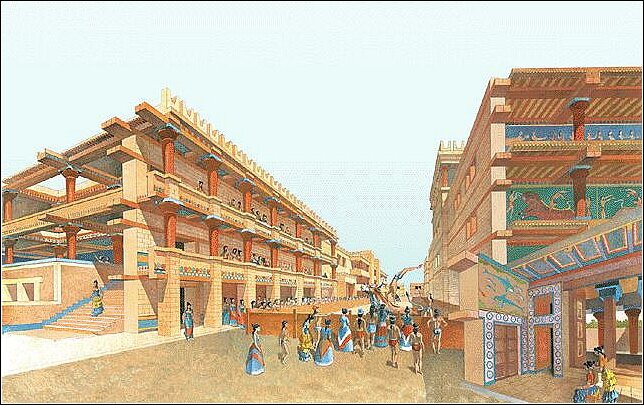 The Minoans were a very spiritual and ritualistic culture. Nature
and harmony were important themes throughout their history. This society was
very advanced for their time, and had a flourishing economy based upon intense
commercial activity revolving around their abundance of natural resources. The
Minoan civilization goes back before 2600 BCE, but little is known about them
before then (“History of Minoan Crete”). One of the biggest mysteries though,
is why their advanced and thriving society crumbled around 1450 BCE. No matter
the reason for their fall, the Minoans made considerable contributions to the
development and growth of Western civilization as it is recognized today.
The Minoans were a very spiritual and ritualistic culture. Nature
and harmony were important themes throughout their history. This society was
very advanced for their time, and had a flourishing economy based upon intense
commercial activity revolving around their abundance of natural resources. The
Minoan civilization goes back before 2600 BCE, but little is known about them
before then (“History of Minoan Crete”). One of the biggest mysteries though,
is why their advanced and thriving society crumbled around 1450 BCE. No matter
the reason for their fall, the Minoans made considerable contributions to the
development and growth of Western civilization as it is recognized today.
The people of Minoan Crete were very in tuned with nature. This becomes obvious
when looking at their unique art and architecture. Spirituality and ritualism
was a significant part of their lives. They loved to celebrate life and the
natural world by holding many religious festivals, mostly in honor of the
natural elements, and their goddesses and gods. Apparently the ritual
celebrations were held in sacred caves, sanctuaries, palaces, villas, and on
mountain peaks. These festivals consisted of animal and bloodless sacrifices,
and processions that were intended for worship of the great female nature
goddess (“Minoan Culture”).The Minoan’s art and spirituality obviously go hand
in hand, which gives us a better understanding about the character of the
people, and the workings of their society.
Their art, no matter what medium, was always very stylized, included curvilinear forms, and conveyed energetic and active scenes. People were depicted on frescoes and in sculptures with long limbs, broad shoulders, and narrow waists. Women were
usually shown bare-breasted and dressed in large layered skirts to emphasize their hips (“Minoan Sculpture” Boundless).
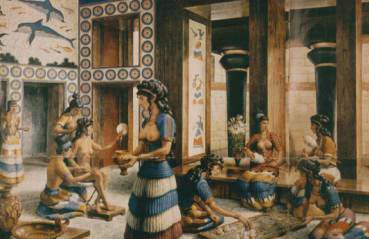
The materials they used to create their works of art speak a lot about their
economic circumstances, as many of the materials were obtained from trading
with other societies. Many of the sculptures were made from materials such as
ivory, bronze, gold, and faience. Materials like faience (quartz ceramic),
which is found in various sculptures, were shipped raw from Egypt to Crete.
However, many of the sculptures were produced in bronze, a vital material in
Minoan culture, which is significant because it shows that they created these
works using a lost-wax casting technique (“Minoan Sculpture” Boundless).

One of the most prominent symbols seems to be of the bull (“Minoan
Culture”), as many paintings and sculptures depict bulls and the act of
bull-leaping. According to an insert on The British Museum website, the Minoans
chose to frequently depict bull-leaping because it was most likely part of ritual
activity. Bull-leaping sculptures and frescoes illustrate a bull in a “flying
gallop” and an acrobat flipping over its back (about to launch off the bull).
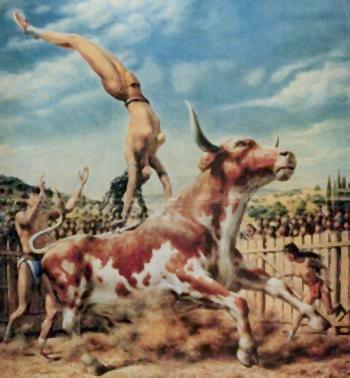
Bull-leaping demonstrates how the Minoans frequently portrayed a high degree of
movement in their art. Furthermore, it’s conceived that bulls hold religious
importance to the Minoans because they are a symbol of strength and power (The
British Museum). Other forms of art exhibiting the bull include ritual objects
such as the bull mask and bull horns. According to the article “Minoan Culture”
on Ancient-Greece.org, this attraction to the bull is relevant to games such as
“taurokatharpsia” that revolve around the animal and the sacrifice of the bull,
which was a fundamental component in Minoan religious festivities. It is
thought that this symbolizes
human interaction with powerful nature elements,
and man’s “triumph over them through skill and power” (“Minoan Culture”).
Other traditional symbols represented in their art, were of their
goddesses or priestesses. A good example of this can be seen with the figure
called “Snake Goddess,” which is a sculpture of a woman holding snakes in her
hands with open arms, and a cat sitting on her head. While the purpose of the
statue is unidentified, experts believe that she represents a Minoan earth
goddess or priestess and that the chthonic animals (the snake and feline)
accompanying her are also symbols of earth deities (“Minoan Sculpture”
Boundless).
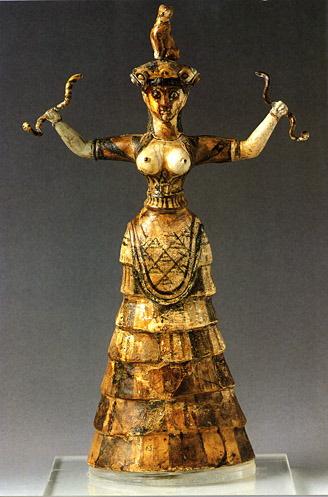
Aside from their fascination of themes like goddesses and bulls,
the Minoans also loved to create scenes of marine life on Kamares-ware (pottery
made from fine clay) and frescoes. Minoan Kameres-ware depicts marine scenes
and abstract flowers, geometric lines, and shapes. It is clear just from
observing their art, that the Minoans were
devoted and inspired deeply by the
nature of the sea as well as the earth (“Minoan Painting” Boundless).

During the time, the Minoan civilization was, what author Matthew Zuk describes as, the
“powerhouse of the Mediterranean Sea” and one of “the most powerful
civilizations of the ancient world”.
They are one of the most advanced
civilizations ever discovered, and based on many archaeological discoveries
proves to be a civilization of equal or greater level of advancement than that
of the Romans of 1,400 years later! Sites such as the Palace of Knossos on the
island of Crete, the town of Akrotiri, the Palace at Zominthos, perfectly
demonstrate the level of sophistication that the Minoans had. These places
contain architectural features that were unparalleled for their time, like
plumbing, drainage, use of light reflection and air management, massive
structures, strategic location, and seismic resistance. On another note, these
sites were also great sources for important cultural artifacts that tell us a
great deal more about their society (Zuk).
The most impressive of all the ruins is the Palace of Knossos,
which had a far-reaching drainage system and water supply throughout the
structure. Even the toilets were of ingenious design, where waste would drop
down a clay pipe to the subterranean sewage system below the town into a
cesspit. Astonishingly, the pipes were created in a particular way that drew
the pungent smells down the pipes away from the people! Aside from great
plumbing, Knossos also possesses a very clever configuration for lighting and
air control. The Minoans used the central staircase to as a light well to
illuminate the inner rooms of the palace, and used a creative system called the
“peer and door partitioning,” which is an arrangement of rows of pillars
holding wooden shutters that can open or close to regulate air flow within the
inner rooms (Zuk).

The town of Akrotiri on the island of Thera (just outside the
Palace of Knossos) provides concrete evidence that there were ancient Minoan
towns (other than palaces) outside of Crete, and contains astounding
technological achievements.

In Akrotiri, there was the presence of a system
that allowed fresh water to run through every building, even to second floors.
Akrotiri also had a sophisticated sewage system just like the Palace of Knossos.

Zominthos, a large palace, is significant because it covers an area of 17,000
square feet and boasted at least two or three floors and the entire place had
ceramic water conduits for their central drainage system. Zominthos was
distinct and special because of the location at which it was built. It is a
special structure that provides further evidence of how advanced the Minoans
were because of the high elevation at which the complex was built. The nature
of the structure was strategically constructed to withstand the harsher environment,
and even control the surrounding area. This is significant not only because it
reinforces the implications that ancient man was highly intelligent, but also
because it shows that the Minoans had the ability to adapt to higher altitudes
and colder weather (Matthew Zuk).
The Minoans weren’t just highly advanced in terms of architecture; they were also master craftsmen when it came to the art of metalworking, and created beautifully skillful jewelry which was
not only worn by the people, but also exported all over the area. Because of
this, all over the ancient world they were highly renowned in the art of
metal-smithing (“Minoan Civilization”). Aside from metalworking the Minoans
were renowned for their sophisticated stone, ivory and faience work, because of
the high degree of craftsmanship in such works as dynamic ivory sculpture, tiny
carved gold rings and seals, alabaster jars, and more!

The Minoan civilization was indeed an astoundingly advanced civilization, but they wouldn’t have reached their
degree of sophistication without one of the most important facets of
human-kind, language and writing. In their early days the Minoans used hieroglyphics
writing, but then later developed a more complex writing system. Their main
language is called Linear A by archaeologists, historians, and linguists. The
interesting thing is that Linear A still hasn't been deciphered. Apparently
Minoans also used Linear B. The two languages are very similar, but are not the
same. Linear A is more like Sanskrit and more like the language from ancient
India, whereas Linear B is an ancestor of the Greek language. These scripts
were most commonly found on clay tablets, but writings have also been found on
discs, such as the "Phaistos Disc" (HistoryWiz). Moreover, Matthew Zuk’s article states that the Minoans had the first written language in Europe, with a sophisticated code of laws too.

What we do know about the Minoan government and economy is actually very interesting and ties in with their culture. They were obviously a sea-faring culture (as they were on an island) that traded and had contact with many foreign societies
throughout the Mediterranean and Aegean, which is clear because of their
Egyptian and “Near East” influences.

Their culture was based on intense commercial activity, and they exported a variety of goods including pottery,
olive oil, wine (Cartwright), timber (cypress wood), currants, wool cloth, herbs,
and purple dye (“History of Minoan Crete”). The imported just as many goods
too, such as ivory, gold, silver, precious stones, and other raw materials.
Interestingly, they also imported tin (used in bronze alloys), which is
incredibly impressive considering the closest mines of their day were located
in central Europe, as far as Spain, Britain, and Iran (“History of Minoan
Crete”).

Furthermore, the Minoans had developed a considerable naval power. For hundreds of years they existed in contact with all the most important civilizations of the era, without being threatened by any external
forces (“History of Minoan Crete”). The Ancient history Encyclopedia article by
Mark Cartwright states that no fortifications in the settlements have been
found, which implies that the Minoans lived fairly peacefully in coexistence
with different communities. Nonetheless, weapons have been discovered like
daggers, swords, arrow-heads, and defensive equipment, which is evidence that
they were either not always peaceful, or perhaps had those items for
authoritative purposes.

Evidence clearly tells us that the Palaces of the Minoan
civilization were imperative to localized control, as a power structure, as
well as a gathering place, and storage place for items such as wine, oil,
grain, ceramics, and precious metals. Aside from that, the many palaces of the
Minoan society also acted as local administrative, trade, religious and even
possibly political centers (Cartwright). The Neopalatial era (1700-1400 BCE)
was the period where there was economic unity throughout the island, and Minoan
Crete was in its “golden age.”

Unlike most civilizations in the ancient world,
women played a powerful role in Minoan society. Also, gold artifacts, seals,
and other items found tell us that there was a very affluent upper class. This
period was also when a paved road network was immensely expanded to connect
most of the major palaces and towns, most likely for ease of trade and
transportation.

Towards the end of this period, we saw the rise of other
prominent societies such as the Mycenaeans. Due to the rise in competition, the
Minoans became more militaristic, which is speculated since large quantities of
weapons were found for the first time in royal tombs around this time (“History
of Minoan Crete”).
While there were
many times when palaces were destroyed throughout ancient Minoan history, the
always seemed to rebuild and move one. However, during this last period, the
flourishing culture eventually came to a halt, and for reasons that are still
highly debated today. Some sources, like the article “History of Minoan Crete,”
speculate that they met their end after most of the palaces and villas of the
country side were destroyed in the mid 15th century, especially
after the Palace Knossos fell. There is evidence in Linear B clay tablets that
suggest the Mycenaeans moved in and controlled the island, but long after the
Minoans abandoned these sites. Some scholars also ascertain that other likely causes
could be either an invasion of outside forces, or a massive eruption of the
Thera volcano (“History of Minoan Crete”), though the exact date of any
cataclysmic eruption is disputed (Cartwright), and if the Minoans were invaded
or assimilated scholars don’t yet know which society is the culprit.
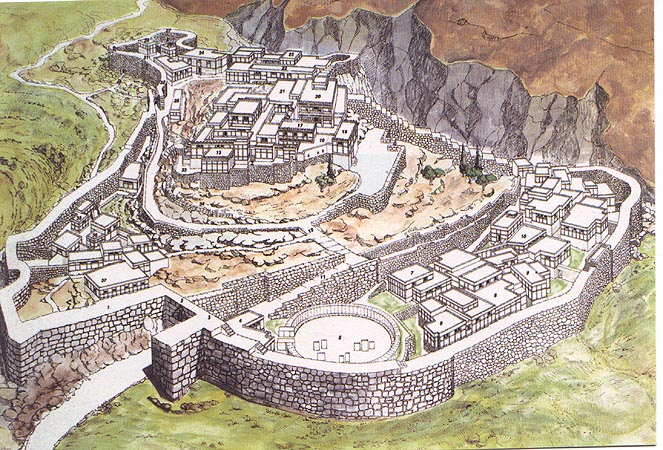
The Minoan civilization was truly an awe
inspiring one to say the least, with their beautiful art, sophisticated
architecture and technology, generally peaceful way of life, and expansive
trade system. What made this culture different and why were they so spiritual?
I believe it's because they lived on an island and nature was hugely integrated into their society,
because they were surrounded by it.
Imagine living on Crete in the ancient world, surrounded by the powerful and
mysterious ocean. They basically worshiped Mother Nature, or should I say, the Mothers
of nature. Male gods were minor, while goddesses were largely important and
powerful and are seen more in Minoan art. The article “Minoan Culture” explains
it perfectly, that the Minoans "deified the natural world and found in it
a logical order that allowed man to live in harmony with the natural
environment." They found beauty and wonder in animals and elements. With
the deification of the natural world, ritual seems to follow. They would hold
ritualistic festivals, during which, the people used a mixture of "music,
dance, and prayer to achieve a state of religious ecstasy that put them in
touch with the supernatural". To me it seems like they wanted to have fun
and celebrate the things in life that were most important to them, also I'm
sure, in hopes of pleasing the goddesses and gods. It is a true shame that
their marvelous, extraordinary society had to come to such a mysterious halt.
Cartwright, Mark. "Minoan Civilization."
Ancient
History Encyclopedia. 2 Sept. 2009. Web. 9 June 2014.
"History of Minoan Crete." Ancient-Greece.org.
Web. 9 June 2014.
"Linear A - the Minoan Language -
HistoryWiz Ancient History." HistoryWiz Ancient History.Web. 14 June 2014.
"Minoan Bull leaper." British Museum.
Web. 19 June 2014.
"Minoan Culture." Ancient-Greece.org.
Web. 9 June 2014.
"Painting - Boundless Open Textbook." Boundless.
Web. 19 June 2014.
"Sculpture - Boundless Open Textbook." Boundless.
Web. 19 June 2014.
Zuk, Matthew. "The Minoan Civilization: Proof
of Advanced Nature." The Genius of Ancient Man.
17 Apr. 2013. Web. 18 June 2014.
















No comments:
Post a Comment